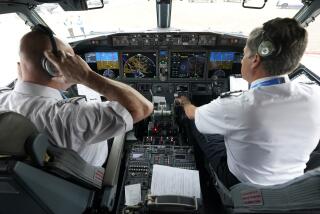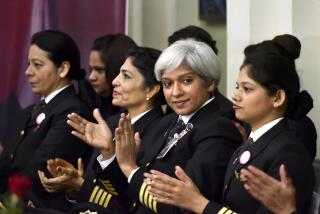Aviation School Soars as Demand for Aviation Workers Mushrooms
- Share via
PRESCOTT, Ariz. — Some pilots do a double-take when they spot the crumpled wreckage of several small planes scattered among a patch of scrub oak and pinyon pines not far from the Prescott airport.
The scene of a major air disaster? No, a laboratory for budding aviation-accident investigators on the campus of Embry-Riddle Aeronautical University.
Sprawling across 540 acres outside this mile-high city 100 miles north of Phoenix, Embry-Riddle has quietly been turning out pilots, engineers, aviation safety experts and investigators for two decades.
“Many longtime Prescott residents don’t even know we’re here,” said Dan Carrell, chairman of Embry-Riddle’s flight school.
Largely unknown to the general public, the school is legendary in the aviation industry. And, thanks to explosive growth in the airline industry, Embry-Riddle graduates are in high demand. Enrollment has climbed 10% in each of the last three years, to 1,500 students today, said interim Chancellor Jeff Ashworth.
“The pilot industry is going crazy,” he said. “Over the next six years, we’re going to have to replace one-third of all the pilots that are flying in the major airlines now. And Boeing is building planes as fast as they can build them.
“What’s happening in the industry right now is the best thing that could happen to us at Embry-Riddle.”
Embry-Riddle opened its campus here in 1978 in buildings formerly occupied by Prescott College, which went broke. Near-perfect flying conditions--the San Francisco Peaks, 60 miles away, are clearly visible most days--make Prescott an ideal location for a flight school, Ashworth said.
The school offers bachelor’s and master’s degrees in a dozen aviation fields, with aeronautical science and engineering the most popular majors.
Embry-Riddle has a larger sister campus in Daytona Beach, Fla., and offers degree programs through more than 125 extended campuses in the United States and Europe.
Embry-Riddle students take to the wide high-desert skies in the school’s fleet of 47 single- and twin-engine Cessnas and Beechcrafts to get the training that will eventually lead to careers as commercial and corporate pilots.
In fact, Prescott’s Love Field bustles with so many takeoffs and landings that it ranks second only to Phoenix’s Sky Harbor as Arizona’s busiest airport.
Students who study at Embry-Riddle, set against a scenic backdrop of thick pines and low-rising mountains, aren’t the undecided type still trying to settle on a major.
They chose the nation’s oldest and most prestigious aviation school, founded in Cincinnati in 1926, because their sights are set on a career in the booming aviation and aerospace fields, Ashworth said.
After picking up a four-year aeronautical science degree--at a cost of about $14,000 a year--and amassing about 1,500 flight hours, Embry-Riddle students typically are hired by commuter airlines and as corporate pilots.
From there, it’s a shorter hop to the cockpit of major carriers than it used to be because military downsizing has reduced a significant source of pilots for the airlines.
Tim Barnes, a 21-year-old senior aeronautical science major from San Diego, said the cost of his education is worth it. He hopes to start his career as a corporate pilot and eventually land a lucrative job with a major airline.
“On the top end of the scale, senior pilots at Delta make around $172,000 a year. Most other airlines are somewhere in that general vicinity, and some Federal Express pilots are making up to $300,000 a year with overtime,” he said.
The aerospace and aviation industries are so hot now that students graduating with degrees in electrical engineering, computer engineering and computer science virtually have their pick of jobs, said Ray Bellem, chairman of the Electrical Engineering and Computer Science Department.
“Four years ago we were struggling to get our students employed. Now, we can’t produce enough of them” for companies like Honeywell, Boeing, Allied Signal, McDonnell Douglas and Rockwell International, he said.
Some graduates earn as much as their professors in their first jobs. Recent electrical engineering grad Mark LeVake nabbed a $40,000-plus salary working for an information technology service provider in Loveland, Colo.
“The Embry-Riddle name is becoming well known in this field, and so companies are really looking for graduates of this school,” LeVake said.
Some of the federal government’s top airline accident investigators got their training at the Robertson Aviation Safety Center and Aircraft Investigation Laboratory at the Prescott school.
Aeronautical science professor Bill Waldock has scattered about half a dozen planes he’s retrieved from real crashes around his eight-acre outdoor lab. The sight has startled more than a few passing pilots.
Waldock’s students pore over the actual accident reports. Then they set out to find the cause--gaining sleuthing skills that will help them in future jobs with the National Transportation Safety Board, Federal Aviation Administration, the airlines and insurance companies.
“It’s as close to reality as we can get,” Waldock said, pointing to the charred earth that he personally set afire.
More to Read
Sign up for Essential California
The most important California stories and recommendations in your inbox every morning.
You may occasionally receive promotional content from the Los Angeles Times.













